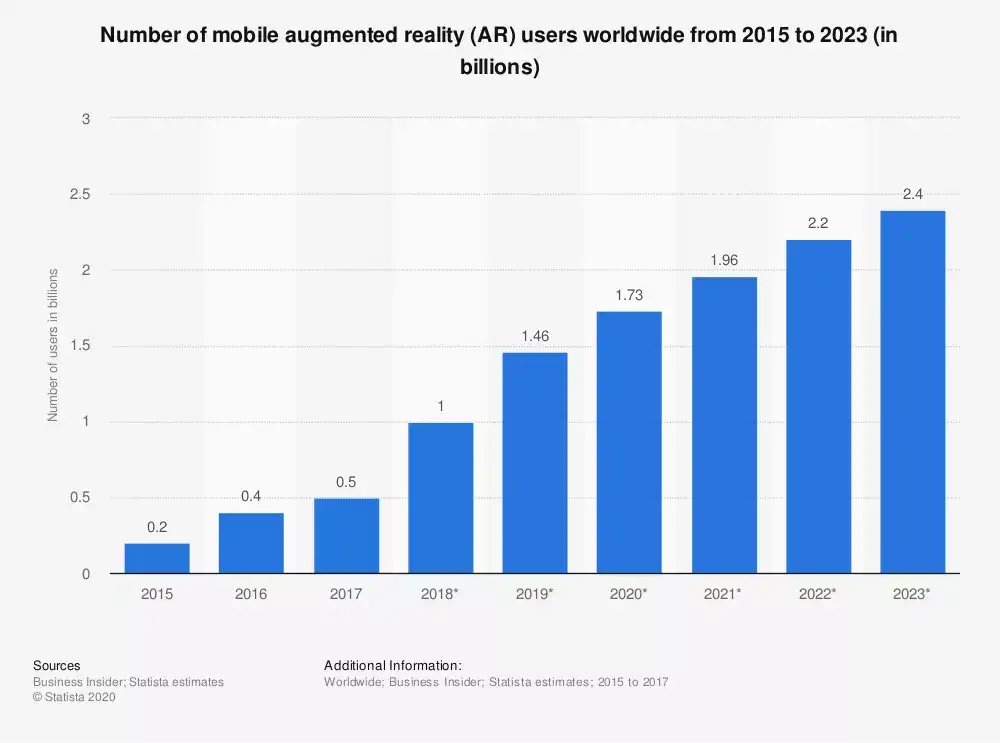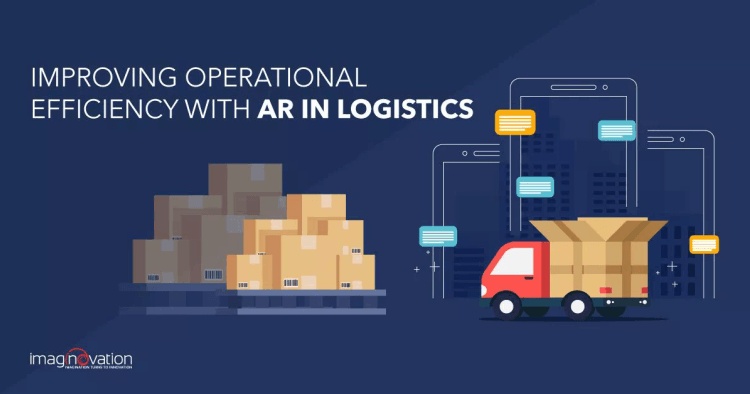Augmented Reality has been around for quite some time now. From science fiction TV shows to games such as Pokémon Go, augmented reality or AR has developed into a revolutionary technology, which finds its use everywhere today.
The potential benefits of Augmented Reality in businesses are not confined to a select few domains only. Today, AR helps businesses of various types and industries, address their business challenges, and make better profits. Companies are finding new ways to utilize AR for their businesses.
Although the use of Augmented Reality is still in its infancy in the logistics sector, many shipping and logistics companies have invested in the AR technology to improve their operational efficiency in the last few years. These companies are using AR-enabled apps and tools to optimize the productivity and efficiency of complex business processes.
Let us take a look at some of the growing trends of AR technology.
Some Interesting Stats About AR
Tech giants like Google, Apple, Microsoft, and Facebook are investing big time in Augmented Reality. We can take a look at what some of their leaders think about the future of AR.
Apple CEO, Tim Cook: (At the company’s first fiscal quarter earnings conference call in 2020).
“There are consumer applications and there are enterprise applications. This is the reason we’re so excited about AR*. You rarely have new technology that both businesses and consumers see as key to them. That’s the reason I think* it’s going to pervade your life – it’s going to go across both business and home life.” (Source)
We can get an insight into the growth of AR from the following figures.
-
The global AR market size is expected to grow to 198 billion USD in 2025 from a mere 3.5 billion USD in 2017. (Source)
-
The number of AR and VR users in the United States is expected to reach over 95 million in 2022 from 59.5 million in 2018. (Source)
-
By 2023, an estimated 2.4 billion mobile users all over the world will start using AR. There will be a sharp increase from the 200 million users in 2015 to 2.2 billion users by 2023. (Source)

As can be seen from the data, AR technology is growing in all the sectors. Many creative AR apps, and solutions, are entering the market every now and then.
Let us explore how logistics and shipping companies are using AR technology.
How can Shipping & Logistics Companies Leverage AR Technology?
Logistics is a customer-centric business. Therefore, it must be able to provide reliable, fast, and secure services. This is where Augmented Reality plays a crucial role. Click To TweetAR presents numerous opportunities to improve efficiency and cost savings in different areas such as warehousing, transportation, material handling, and operations.
During a survey of supply chain leaders held in 2019, 34% of respondents confirmed their planning to invest in AR and/or VR. This pointed towards tremendous growth from only 8% in 2017.
1. AR in Warehousing
A warehouse is a place that is used to store goods for commercial purposes. It is one of the most important parts of the supply chain. Therefore, it must have faultless and well-organized processes. Here’s how AR can be used in warehousing.

Planning the warehouse
The modern-day warehouses are no longer the dumping house or merely a distribution house. Warehouses carry out critical services like product subassembly, repairing, repacking, and dispatching.
AR can greatly help in the overall planning of the warehouse layout. It can create a digital and interactive 3D layout of the existing warehouse and allow users to experiment with changes in real-time.
Just by wearing a device like an AR glass, it can display comprehensive information about the layout with proposed modifications. This way, the logistics company can save a lot of time, money, and efforts in planning and redesign of the warehouses.
Inventory Management
In the traditional ways of inventory management, logistics company employees had to physically move around the warehouse. They had to manually check whether the inventory stock is sufficient in quantity, will be replenished soon, or is in the right condition. Not to mention, these processes were time-consuming and paper-based.
AR makes the inventory management hands free. Applications like AR smart glass would help inventory workers get detailed information on how to perform a particular task.
For example, a worker can see the order number, trolley number, bin information (where the products are dumped), and passage number displayed on the screen. This data will help them in deciding which products should be loaded into which bin. Thus, the loading and unloading process will become quicker.
Picking Order
Order picking accounts for almost 55% of the total operational cost in warehouses. It’s one of the main reasons why order picking should be productive and less prone to any kind of errors.
AR can completely simplify the process. The pick-up personnel can wear smart AR-enabled glasses that update him about the delivery list and other priorities. He can be guided inside the warehouse and thus quickly pick up the orders from the warehouse.
Besides bringing in the efficiency, and speed, such AR logistics services will also help shipping and logistics companies to save their cost of job training.
Also Read: 6 Ways Blockchain Technology Can Boost Your Logistics Business
2. AR in Freight Loading
Today, freight transportation by air, water, or road use digital data and planning software for optimized load planning and vehicle utilization. Issues such as content, weight, size, and destination are taken into account for each item.
AR can speed up the freight loading process when the loader receives instructions, and load plans on the AR-enabled app or headgear.
3. Transportation
Augmented Reality in Transportation can mean having a 3D illustration of the way to pack items in the truck from the warehouse. Additionally, 3D imaging by AR can help in delivering the right products. This will save time and bring efficiency.
Also, AR in the navigation system can show a 3D view of the routes ahead, thus helping the driver to choose the traffic-free, right path. This, too, can save costs.
An AR App or a wearable device can also project critical information about the product being transported. It can show the package’s weight, and if it is fragile, how much space will be needed for storing the package while transporting, and also choosing a suitable spot in the vehicle.
Let’s sum-up how shipping and logistics companies can benefit from AR
- Safe and secure processes for the personnel.
- Improved processes for order pick-ups.
- Predictive modeling to streamline the processes – without errors, irregularities, and delays.
- Much efficient freight loading and unloading
- Optimized transportation
- Optimized space
- Navigation within the warehouse with efficiency
- Streamlined logistics operations
- Productive workforce
- Reduced need for training and supervision of employees
- Cost-saving
- Better utilization of time and efforts
Examples of How Leading Logistics Companies are Utilizing AR Apps
Many leading logistics companies are utilizing the technology of Augmented Reality for their digital transformation.
We must learn from their journey of this process and understand how they’re able to improve the efficiency of their business with the use of AR.

1. DHL
DHL is one of the world’s leading Logistics Companies. The company identified 3 key areas for potential AR use:
- Warehousing operations
- Transportation optimization
- Last-mile delivery
DHL launched its Vision Picking pilot project in 2017 that brought Augmented Reality based smart glasses to the warehouse operations. The solution offered digital picking lists, ways to efficiently navigate the warehouse digitally to find the best route, and items.
AR-enabled smart glasses allowed employees to determine whether they are at the necessary location and help them efficiently locate necessary items on shelves.
This resulted in approximately 25% growth in the picking efficiency along with reduced picking orders and search time – leading to productivity.
In addition, DHL has introduced VR enabled computer-simulated 3D immersive training environments, which allows employees to take part in a number of scenarios without the need for traditional classroom training.
DHL is now looking into the additional applications of augmented and virtual reality into its logistics business like maintenance, dimension calculations, transportation optimization, last-mile delivery, and others.
2. BMW
BMW has produced over 4.8 million BMWs in the U.S. since 1994.
Logistics is the core of the BMW production system because most of the BMW’s parts and vehicles are shipped via sea. Therefore, it was crucial for the company to have efficient supply-chain management.
BMW is currently using smart glasses at its Munich plant. Smart glasses are used like a monitor worn on the nose to display picking information in the worker’s field of vision.
BMW is also promoting a paperless working environment with the help of AR.
In the future, BMW plans to use AR and VR to check whether a vehicle has been constructed properly. The system would make it possible to check if the parts have been placed in correct positions and if they are fitted properly.
More and more of such logistics companies are exploring the potential of Augmented Reality in increasing the efficiency of their businesses.
Therefore, investing in AR-enabled apps for your business can significantly improve your processes and benefit your business.
Conclusion
Are you ready to leverage the power of AR into your logistics business? If yes, then get in touch with us. We have helped companies from different industries boost efficiency with AR.
We are an award-winning web and mobile app development agency with a vast experience of crafting remarkable digital success stories for diverse companies. Let’s talk.




